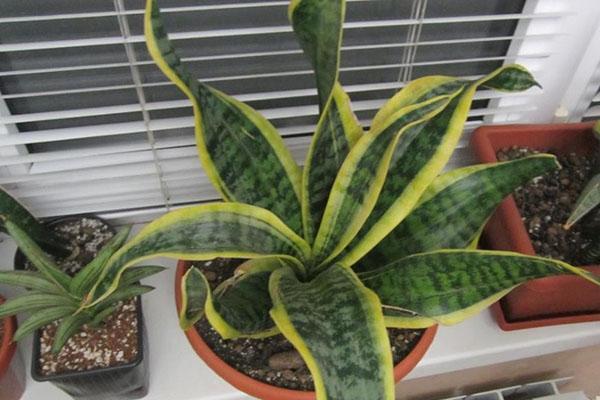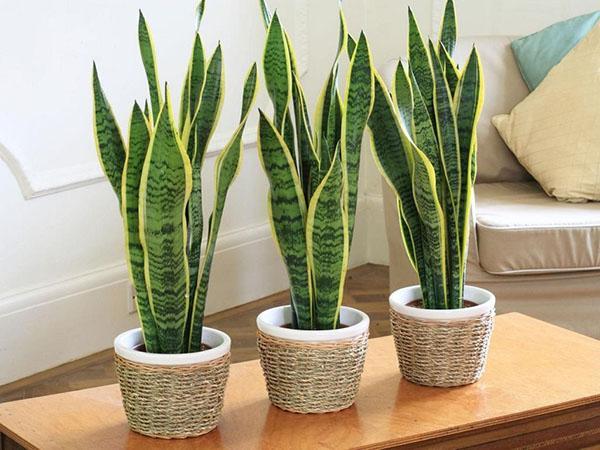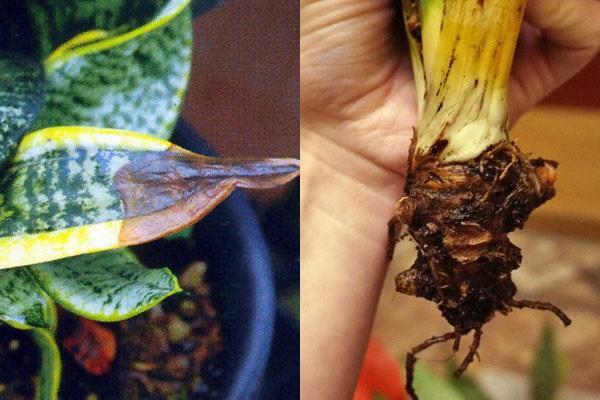Diseases and pests of sansevieria: causes and methods of control
 The indoor plant sansevieria, better known as "mother-in-law's tongue", is quite unpretentious in care and rarely gets sick. However, even this unpretentious plant can be affected by a pest or infection. This article tells about which diseases and pests of sansevieria are the most dangerous and why they occur. Knowing this, it is possible to prevent disease and death of the plant.
The indoor plant sansevieria, better known as "mother-in-law's tongue", is quite unpretentious in care and rarely gets sick. However, even this unpretentious plant can be affected by a pest or infection. This article tells about which diseases and pests of sansevieria are the most dangerous and why they occur. Knowing this, it is possible to prevent disease and death of the plant.
Why are diseases and pests of sansevieria dangerous?

The homeland of this flower is arid, desert, sunny and warm places. Knowing this, you can avoid the most common problems that arise when caring for this flower.
Infectious diseases
 This indoor flower is most often affected by infectious diseases. They are:
This indoor flower is most often affected by infectious diseases. They are:
- soft rot;
- root rot;
- leaf rot.
The table below shows the symptoms of diseases and the causes of their occurrence.
| № | Name | Symptoms | Causes of occurrence |
| 1 | Soft rot | The root part of the leaves becomes soft, looks affected. The plant can give off a rotten fish smell. | At the time of purchase, the flower may already have been infected. The reason why the leaves of sansevieria become soft may also be that the flower was planted in non-sterilized soil. If sansevieria multiplied in a vegetative way, the disease could arise due to high humidity in the room. |
| 2 | Root rot | Young shoots rot. Spots of brown, red or dark color appear on the leaves. Sansevieria leaves curl, they acquire an irregular shape. | If water got on the leaves during watering, this could serve as a catalyst for the development of this disease. The disease itself could be in poor quality or non-sterile soil. |
| 3 | Leaf rot | The presence of round spots on the leaves that are covered with spores. Over time, these spots darken or turn brown. | The presence of infection in poor-quality soil, too frequent and abundant watering. |
Damage by pests
 Sansevieria can be affected by such pests:
Sansevieria can be affected by such pests:
- spider mite;
- thrips;
- mealybug.
More information on how to recognize the presence of a disease in sansevieria caused by pest damage is described in the table below.
| № | Name | Symptoms | Control measures |
| 1 | Spider mite | Defeat spider mite is the reason why sansevieria leaves turn yellow. Whitish spots may appear on yellowed leaves, over time, the leaves die. | Leaves must be wiped with a damp sponge or cloth dipped in citrus peel infusion. If the plant is completely affected, spraying with phytoverm is necessary. |
| 2 | Thrips | The underside of the leaf is mainly affected. Colonies are laid on it. Light spots are visible on the upper side of the sheet. The disease can be recognized by the characteristic color of the upper side of the leaf - it becomes grayish brown and has a silvery sheen. | For treatment, insecticides are used. If the leaves of the sansevieria are falling apart, spraying should be regular and frequent. It is produced until the plant is completely cured. |
| 3 | Mealybug | This insect settles at the base of the leaf rosette. It feeds on juice from the leaves, so the leaves of the sansevieria fall. There may also be a change in their shape and color. | If possible, pests must be collected by hand and destroyed. Leaves should be washed with a damp sponge. If the lesion is severe, and all leaves of the plant are affected, they can be treated with karbofos. |
Growing environment problems
 The main reasons why sansevieria does not grow at home are the wrong conditions of detention. These conditions include:
The main reasons why sansevieria does not grow at home are the wrong conditions of detention. These conditions include:
- waterlogging of the soil;
- low room temperature;
- high humidity.
What the wrong conditions for keeping this flower are fraught with is described in the table below.
| № | Containment Condition | The resulting damage | Corrective measures |
| 1 | Too wet soil | Leaves become important, rot at the base. Yellowness appears. Over time, the leaf dies. | The affected leaves are removed. If the roots begin to rot, the plant is transplanted. The flower is watered less often. |
| 2 | Low air temperature | This factor is the reason why sansevieria has sluggish leaves. Excessively dry soil also contributes to this. | The flower needs to be rearranged to a warmer room. The damaged leaves are removed. If there are too many of them, the plants need to be transplanted. |
| 3 | High room humidity | Brown spots begin to appear on the leaves. Over time, the entire plant is affected. | The plant must be rearranged to a drier and brighter room. It is desirable to get the sun's rays on the leaves. |
Before starting to grow a mother-in-law tongue, study the natural habitat of this plant and try to provide it with the same conditions in the room.
As you can see from the information described in this article, most of the problems that arise with mother-in-law's tongue in the process of growing and breeding it depend on the habitat, the soil in which the flower is planted and the correct planting of the plant in the soil. If you decide to purchase this plant, pay attention to the soil in which it is planted and the health of the leaves. Never buy a flower that looks sluggish, sickly, has soft, curled, yellow, or strangely shiny leaves.  Pay attention to the root zone of the leaves - it should be whole, healthy, firm, there should be no larvae in it. Under the right conditions for keeping mother-in-law, the tongue blooms for many years, and it rarely needs to be transplanted - once every 2-3 years. With regular inspection of the leaves for the purpose of early recognition of the disease, treatment will rarely need to be done.
Pay attention to the root zone of the leaves - it should be whole, healthy, firm, there should be no larvae in it. Under the right conditions for keeping mother-in-law, the tongue blooms for many years, and it rarely needs to be transplanted - once every 2-3 years. With regular inspection of the leaves for the purpose of early recognition of the disease, treatment will rarely need to be done.
Very interesting. Thank.